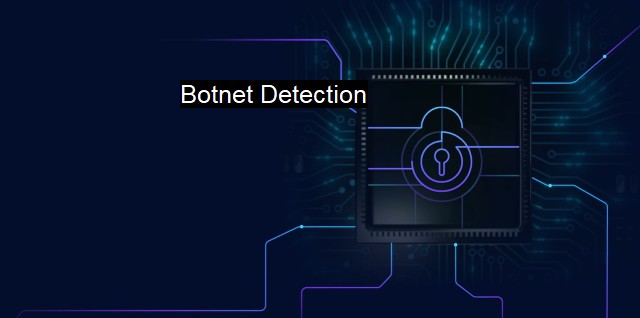What is Botnet Detection?
Battling Botnets: The Importance of Botnet Detection and Strategies for Keeping Them at Bay in a Cyber-Connected World
Botnet detection refers to the process of identifying, observing, and then removing a set of infected computers that have been potentially hijacked by hackers to conduct all sorts of malicious cyber activities. The term 'botnet' comes from the words 'robot' and 'network' and is commonly used within the context of cybersecurity and antivirus software development.It's worth noting that a botnet isn't inherently illegal or malevolent–organizations may use botnets for legal operations, such as distributed processing or indexing web pages. it's the illicit use of botnets by hackers that makes them a major concern in cybersecurity.
In more technical terms, a botnet consists of numerous Internet-connected devices and computers, often referred to as 'bots', brought together to perpetrate cyberattacks. They can disseminate spam emails, steal data, infect other computers with viruses, perform a Denial-of-Service (DoS) attack, or facilitate click fraud. A feature that exacerbates botnets’ threat is their ability to add more devices to the network as they disseminate viruses – a characteristic that aids such networks in maintaining their strength and endurance.
Botnet detection has become a crucial aspect of cybersecurity because the number of cyber threats and attacks by hackers using botnets continues to rise. Detecting it requires vigilance and effective antivirus software because traditionally, there have not been clearly defined perimeter security measures for botnets.
The detection process involves several techniques such as signature-based detection, anomaly-based detection, DNS-based detection, mining-based detection, and machine learning-based detection. Although these techniques have proved to be useful, they aren't competent enough to adapt to evolving and sophisticated botnets, which are starting to show low predictability and high potency.
Signature-based detection systems discover botnets by examining the similarities in code sections within the subject’s previous botnet constructions and its present botnet operation. On the other hand, anomaly-based detection systems focus on using behavioral conformity to identify whether a machine or network is part of a botnet. They are better at detecting new and unknown botnets but could yield higher false positives.
DNS-based botnet detection observes patterns in DNS traffic and detects irregularities that may indicate botnet activity. Mining-based detection uses data mining techniques to assess various network properties and find patterns that suggest botnet activity. machine learning-based detection uses algorithms to analyze network behavior and make predictions about potential botnet activity.
Despite the widespread usage of these techniques, the botnet detection process still has its challenges. First, the approaches adopted raise privacy concerns because many algorithms require deep packet inspection, which invades the privacy of the users. Another challenge lies in the converging network; with IPv6 usage becoming more common, every device has a globally reachable IP, making it easy for hackers to spread botnets throughout these IP-based devices.
Further, very high false positives in anomaly-based systems and reliance on existing virus repositories in signature-based ones necessitate incorporation of more developed and rounded detection methods. The need for advanced detection systems that can monitor a wider range of network tendencies is a pressing necessity for combating these powerful cyber weapons effectively.
These improvements to botnet detection include enhancing the artificial intelligence and machine learning components in antivirus software to better predict the behavior of unknown botnets and improving the deep inspection of packets for anomalies while maintaining privacy at the same time.
Also, evolving internet protocols should take into consideration botnet detection techniques allowing graphene sequencing metals to expand virus repositories to maintain the reliability of signature-based systems remain functional.
Botnets are continually adapting to the environment they function within, becoming more stealthy and challenging to trace. They demand continuous retraining and recalibrating by cybersecurity experts who strive to provide cohesive defense systems.
Botnet detection is a complicated but vital element of cybersecurity that demands continuous advancement and investment. Developers and cybersecurity experts alike have the task of finding successful techniques to detect botnets and, more importantly, eliminate the threats imposed by hackers who continuously adapt these insidious networks to their benefit. By improving the fields of detection surveyed, we can better secure our connected systems and data from malicious actions embodied by botnets.

Botnet Detection FAQs
What is botnet detection?
Botnet detection refers to the process of identifying and preventing the spread of botnets, which are networks of infected devices controlled by cybercriminals.How does botnet detection work?
Botnet detection software uses a variety of methods to identify the presence of botnets on a network, including analyzing traffic patterns, monitoring for known botnet command and control (C&C) servers, and detecting unusual network behavior.What are the benefits of botnet detection?
Botnet detection helps prevent cybercriminals from using infected devices to launch attacks on other networks and steal sensitive information. It also helps mitigate the damage caused by botnet attacks, such as distributed denial of service (DDoS) attacks, which can slow or shut down websites and online services.What are some common botnet detection tools?
There are a variety of botnet detection tools available, including antivirus software, network intrusion detection systems (IDS), and vulnerability scanners. Some popular examples include Norton Antivirus, McAfee, Snort IDS, and Nessus vulnerability scanner.| | A | | | B | | | C | | | D | | | E | | | F | | | G | | | H | | | I | | | J | | | K | | | L | | | M | |
| | N | | | O | | | P | | | Q | | | R | | | S | | | T | | | U | | | V | | | W | | | X | | | Y | | | Z | |
| | 1 | | | 2 | | | 3 | | | 4 | | | 7 | | | 8 | | |||||||